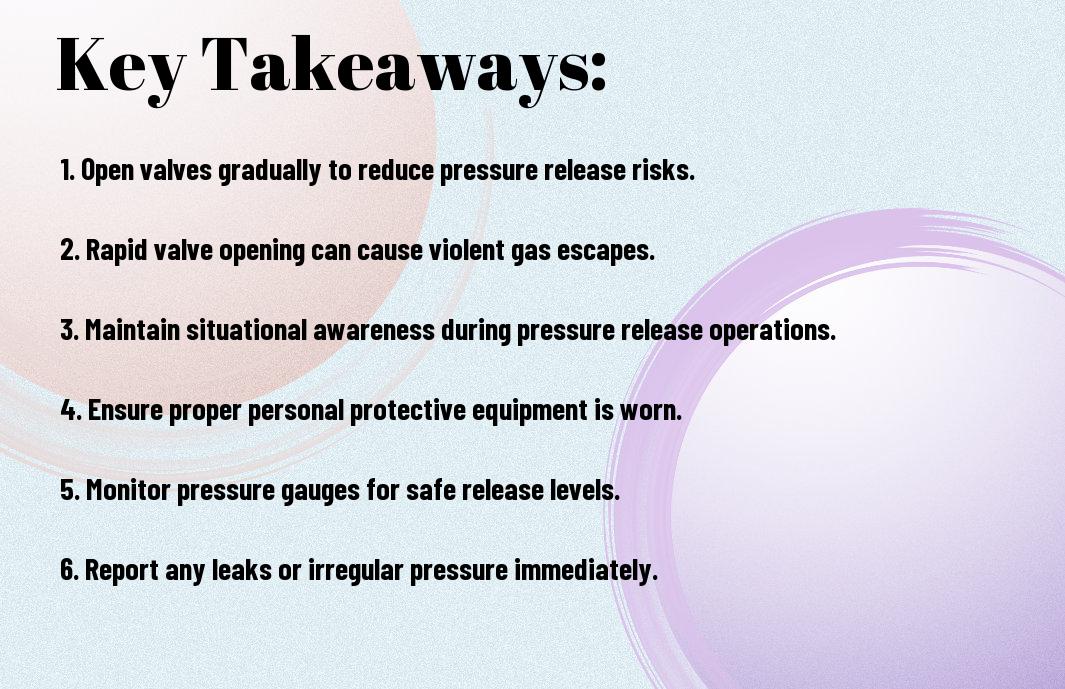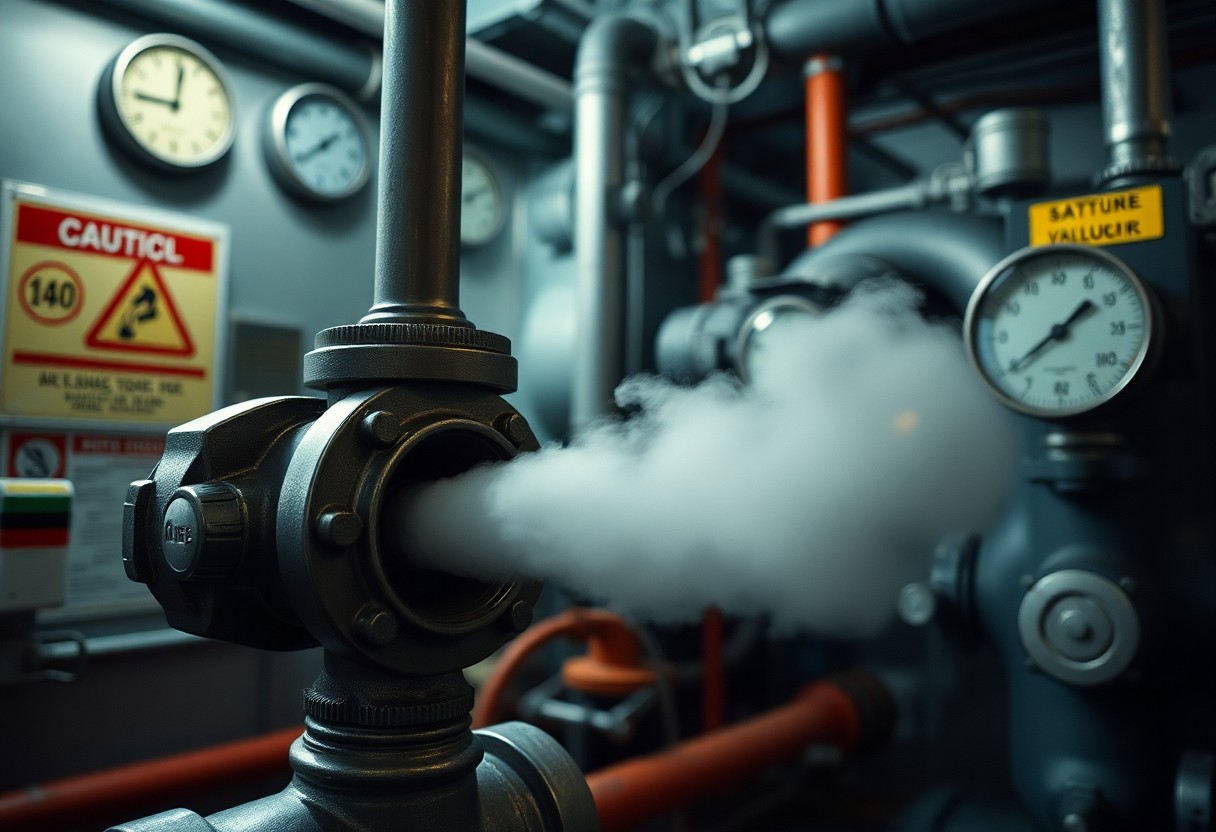Overlooking the *importance of pressure release hazards* can lead to serious accidents and injuries in your workplace. It is vital that you learn to *open valves slowly* to prevent sudden pressure surges that could result in catastrophic failures. By understanding the *potential dangers associated with rapid valve opening*, you can protect yourself and your colleagues while ensuring a safe working environment. Prioritizing safe valve operation is key to maintaining *operational integrity* and promoting a culture of safety in your organization.
Key Takeaways:
- Opening valves slowly can prevent sudden pressure changes that may lead to equipment failure or safety incidents.
- Always assess the system’s pressure levels before operating valves to ensure safe handling and reduce the risk of accidents.
- Implementing standard operating procedures for valve operation promotes a culture of safety and minimizes hazard exposure in the workplace.

Understanding Pressure Release Hazards
Before you work with pressurized systems, it’s imperative to understand the risks involved. Pressure release hazards can result in serious accidents or equipment damage if not handled properly. Operating equipment with high-pressure systems requires caution, especially when it involves opening valves or releasing pressure. Your safety and the safety of those around you can depend on how well you manage these situations.
Definition of Pressure Release Hazards
Any situation where the release of pressure can occur suddenly poses a potential risk, often referred to as a pressure release hazard. This can happen in various settings, including industrial sites, laboratories, and even within home appliances. Understanding what constitutes a pressure release hazard is the first step in mitigating risk.
Causes and Effects of Rapid Pressure Release
Above all, rapid pressure release can lead to a range of dangerous outcomes, including explosive decompression, equipment failure, and personal injury. Situations such as sudden valve openings, equipment malfunctions, or improper handling play significant roles in triggering these hazardous events. You must grasp how these conditions can escalate into emergencies to protect yourself.
And the effects of rapid pressure release can be devastating. Not only can you face immediate dangers, like injuries from flying debris, but there can also be long-term repercussions, such as damage to equipment and financial loss. The release of pressurized gases can cause chemical exposure, while even minor leaks may result in catastrophic failures if not managed carefully. Understanding these risks allows you to take proactive measures to ensure safety when dealing with pressurized systems.
Importance of Slow Valve Operation
While operating valves, it’s important to do so slowly to mitigate risks associated with pressure release hazards. Rapid valve operation can lead to unexpected pressure surges, resulting in potential equipment failure or accidents. Understanding the mechanics of your system can significantly improve safety practices. For more information, check out What is a Pressure Control Valve? Safety vs. Relief ….
Benefits of Controlled Release
Below, you will find that controlling the release of pressure not only enhances safety but also increases the longevity of your equipment. A gradual release prevents sudden changes in pressure, reducing fatigue on components and ensuring a safer working environment.
Preventing Equipment Damage
Below, understanding the importance of slow valve operation can greatly help in preventing significant equipment damage.
Controlled valve operation minimizes the risk of sudden pressure changes that can wreak havoc on your systems. By releasing pressure slowly, you protect your equipment from stress fractures and premature wear. This proactive approach not only extends the life of your valves but also reduces the need for costly repairs and replacements, ensuring that your machinery continues to function safely and efficiently.
Best Practices for Opening Valves
For safe valve operations, always adhere to established best practices. You need to assess the system’s pressure and check for any signs of wear or leaks before proceeding. It’s crucial to communicate with your team and ensure that everyone is aware of the valve operation, as this promotes a safe work environment. Be prepared to act quickly but methodically, prioritizing safety above all.
Step-by-Step Procedure
StepbyStep, follow this simple procedure when opening valves:
| Step | Action |
| 1 | Check pressure levels and conditions. |
| 2 | Notify your team of your intention to open the valve. |
| 3 | Open the valve slowly and steadily. |
| 4 | Monitor for unexpected pressure changes. |
| 5 | Close the valve tightly after use. |
Safety Gear and Equipment
To protect yourself during valve operations, always wear appropriate safety gear. This includes safety goggles, gloves, and flame-resistant clothing. Consistently using such gear reduces the risk of injury from chemical exposure or sudden pressure release.
Even the best safety practices can fall short without proper safety gear and equipment. Your safety goggles shield your eyes from hazardous materials, while gloves protect your hands from dangerous substances. It’s imperative to wear flame-resistant clothing to guard against any fire risks during valve operations. This ensures you are safeguarded against potential accidents and makes a significant difference in your safety. Always prioritize your safety by equipping yourself with the necessary protective gear before engaging in any valve activities.
Training and Awareness
Keep in mind that effective training and awareness programs are imperative to mitigate pressure release hazards. These initiatives help you and your team to recognize potential risks associated with open valves, understand safe practices, and respond appropriately in emergency situations. By prioritizing these training sessions, you promote a safer working environment and empower your employees to take ownership of their safety and that of their colleagues.
Employee Training Programs
Across various industries, tailored employee training programs focused on pressure release hazards are vital for promoting safety. These programs should cover topics such as the proper techniques for opening valves, potential consequences of rapid pressure changes, and emergency response options. Regularly updating and reinforcing training helps ensure that you and your colleagues remain vigilant and knowledgeable about safety practices.
Importance of Safety Culture
Against the backdrop of workplace hazards, fostering a strong safety culture is imperative. When safety becomes an integral part of your daily routine, it creates an environment where everyone actively prioritizes safety measures. This cultural shift encourages you and your peers to communicate openly about safety concerns, share experiences, and collectively find solutions to mitigate risks.
Considering the implications of a strong safety culture, you can see how it directly impacts workplace health and productivity. When everyone shares the commitment to safety, it leads to increased awareness of pressure release hazards and the proactive behaviors necessary to prevent incidents. Employees become more likely to report hazards and suggest improvements, promoting a collaborative environment. Ultimately, a positive safety culture not only protects you but enhances overall team morale and efficiency.
Case Studies
Many safety incidents involving pressure release have been documented, highlighting the need for cautious valve operation. Here are key case studies that illustrate these hazards:
- Incident 1: In 2018, a chemical plant experienced a catastrophic failure due to rapid pressure release, resulting in $2 million in damages and one injury.
- Incident 2: A gas facility faced an explosion caused by improperly opened valves, leading to 500+ evacuated residents and a significant financial loss.
- Incident 3: In 2020, a manufacturing unit reported a minor explosion from a valve opening too quickly, causing $100,000 in damages but no injuries.
Incidents from Rapid Pressure Release
Before addressing the lessons learned, it’s important to examine incidents caused by rapid pressure release. In these occurrences, unanticipated situations can lead to explosions or releases of hazardous materials, posing a significant threat to both personnel and equipment.
Lessons Learned
Beside reviewing case studies, understanding the lessons learned is vital in preventing similar incidents. Key strategies include implementing strict operational protocols and regular valve maintenance schedules to ensure you operate valves safely.
Learned from these incidents, the most important precaution is to always open valves slowly to allow for proper pressure stabilization. Additionally, investing in training programs for employees ensures they are equipped with the knowledge required to manage pressure release hazards effectively. A culture of safety and adherence to established procedures significantly minimizes the risk of accidents and enhances overall operational safety.
Regulatory Standards and Guidelines
After understanding the hazards associated with pressure release, it’s vital to familiarize yourself with the relevant regulatory standards and guidelines that govern safe practices. Regulations set forth by organizations such as OSHA, EPA, and ANSI provide comprehensive frameworks that help you mitigate risks during valve operations. Complying with these guidelines not only enhances workplace safety but also ensures legal compliance, safeguarding your team against potential accidents.
Overview of Relevant Regulations
Against the backdrop of safety concerns, regulatory bodies have established specific standards to manage pressure release hazards effectively. These regulations dictate how to operate valves and equipment, including pressure limitations, maintenance protocols, and training requirements. Being aware of these regulations allows you to protect your personnel and equipment while fostering a culture of safety.
Compliance and Best Practices
One of the most effective ways to ensure your operations are safe is through compliance with established standards and adoption of best practices. This means conducting regular safety audits, providing appropriate training for your team, and implementing safe operational procedures when handling pressurized systems.
Indeed, by prioritizing compliance and adopting best practices, you can significantly reduce the likelihood of accidents. Ensure that you and your team undergo thorough training focused on the importance of slowly opening valves to prevent pressure surges that can lead to catastrophic failures. Regularly review and update your safety protocols and conduct safety drills to reinforce the behaviors that contribute to a safe work environment. Your commitment to these practices can make a significant difference in promoting a culture of safety and accountability.
Final Words
Conclusively, addressing pressure release hazards is vital for ensuring your safety when working with pressurized systems. By mastering the practice of opening valves slowly, you can mitigate the risks associated with sudden pressure changes, which can lead to unexpected accidents or equipment failures. Always stay vigilant and adhere to safety protocols to protect yourself and your coworkers in the workplace. Your commitment to safety not only fosters a secure environment but also enhances overall operational efficiency.
Q: What are the potential hazards of opening valves too quickly?
A: Opening valves rapidly can create sudden pressure changes within a system, leading to the release of hazardous materials or high-pressure gas. This can result in explosive decompression, system damage, or injury to personnel. It is important to gradually open valves to manage the pressure more safely, allowing for controlled release and minimizing risks of accidents.
Q: How should I proceed if a valve is stuck or difficult to open slowly?
A: If a valve appears stuck, avoid using excessive force to open it. Instead, check for any obstructions or accumulated debris that may be preventing movement. If necessary, seek assistance from a qualified technician who can safely assess and remedy the situation. Always prioritize safety and use appropriate tools or methods recommended for valve maintenance.
Q: What safety measures should be in place before opening a pressurized valve?
A: Before opening any pressurized valve, ensure that proper personal protective equipment (PPE) is worn, such as safety goggles, gloves, and face shields. Conduct a hazard assessment of the environment, and make sure all personnel are informed and at a safe distance. Additionally, verify that any safety devices are functioning and that an emergency response plan is in place should an incident occur.

Leave a Reply